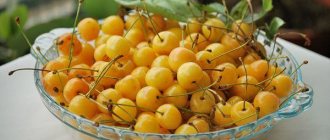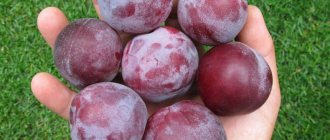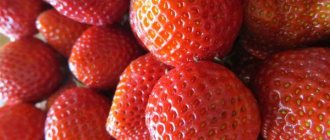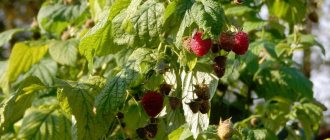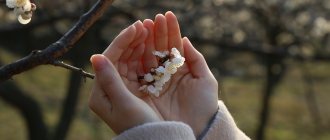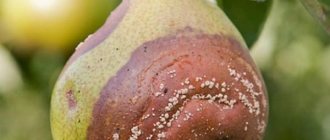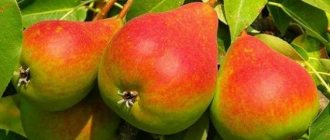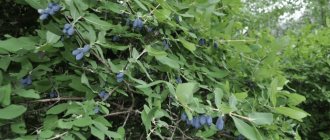History of variety selection
Large-fruited cherries were bred in the 70s of the last century at the Ukrainian Research Institute of Irrigated Horticulture. The authors of the variety were Ukrainian scientists M. T. Oratovsky and N. I. Turovtsev.
The crop was obtained as a result of pollination of the Napoleon variety with a combination of cherry pollen by Valery Chkalov and Elton Zhabule.
Did you know? Green food coloring is produced from cherry berries.
Already in 1983, large-fruited cherries were included in the Ukrainian register of varietal plants. The culture quickly spread throughout Ukraine and other countries of the post-Soviet space. In Russia it is cultivated in the Southern and Central regions.
The largest fruited trees, their characteristics
If you want to grow fruits with excellent presentation and sell them at a higher price, then you need to pay attention to the following description of cherry varieties. They do not have any supernatural taste qualities, their yield is average or slightly above average, but the mass of fruits significantly exceeds ordinary berries. Here are several descriptions of the “heavyweights” in alphabetical order.
- Cherry Bull's heart. One of the largest-fruited, the weight of one berry can reach 8 grams, which is an unprecedented result for 90% of all results of domestic selection and foreign selection. The crown has a pyramidal appearance, and the natural neglect is slight. The only negative is that the fruits crack when ripe, especially if the weather outside alternates with a dry, hot wind. Great taste, slight sourness. It has a dark color and excellent presentation. It is poorly transported, shelf life is low, winter hardiness is high, and easily tolerates frosts down to -25 degrees.
- Daibera black cherry. It bears fruit only in the 5th year of growth, but immediately produces 7-9 kg per plant. By the 11th year it bears fruit in full and you can harvest up to 60 kg from one tree, due to this the yield per hectare reaches 90 centners. One of the biggest advantages of this tree is the size of the fruit - the average weight reaches 6.6 grams, which is quite a lot for this type of fruit. Sweet, up to 12% sugar, at the stage of technical ripeness has a black color, as well as a characteristic odor, which is much stronger than usual. It is in great demand on the market, as it has an excellent presentation, is easily transported and lasts for several weeks. It does not crack in normal weather, but during rain some fruits may crack if the fruit is ripe. Daibera is superior to the best cherry varieties of European selection, especially in terms of fruit weight. This is a “must have” for every summer resident!
- Italian. It is difficult to imagine early varieties of cherries without this bright representative, whose fruit weight is 6.8 grams, with some fruits weighing 8 grams. A worthy competitor to the best Dutch options, which is extremely popular in Russia, Belarus, Kazakhstan and Iran. It is grown in temperate climate zones and hotter regions, does not require large amounts of water and fertilizers, and produces stable, albeit small, yields. Up to 80 c/ha can be harvested even in drought and lean years. That is why it is recommended for industrial cultivation. Resistance to pests is excellent, although the keeping quality of the fruit leaves much to be desired - they rot in a few weeks and are poorly transported at the stage of technical ripeness.
Description of culture
The height of a tree of this variety can reach 4-5 m. The crop is characterized by high growth vigor.
The crown shape is spherical. The foliage and density of shoots is average. Skeletal branches are strong and thick. The bark is brown, smooth. The leaves are large, pointed at the ends, serrated at the edges. Painted in rich green color.
The flowers are large, five-petaled, umbrella-shaped. Fruits are formed mainly on bouquet shoots and annual growths.
The berries are large, wide-round, weighing from 10 to 18 g. The peel is dense, dark red, almost black.
The flesh is cartilaginous, juicy, and also colored intense red. The stone is easily separated from the pulp. The taste of the berries is sweet and sour, refreshing.
Description of the cherry variety Large-fruited
The large-fruited black cherry is a medium-sized tree that can grow up to 5 meters in height. The tree has few main skeletal branches, but they are very strong and covered with rough bark.
The natural shape of the crown is usually spherical, unless another is formed artificially, and of medium density. Cherry leaves are unremarkable - oblong in shape, slightly pointed at the ends, juicy green in color. The easiest way to recognize the tree is by its white flowers, which bloom thickly in April and envelop the entire crown of the cherry tree in a light veil.
A unique feature due to which the variety received its expressive name is the unusually massive cherry fruits. One berry can weigh from 10.4 to 12 g, sometimes even fruits weighing 18 g are found. The berries are round in shape, covered with thin but dense skin, the color of which can vary from rich red to almost black. The pulp also has the same color. In terms of ripening time, this variety belongs to the category of mid-ripening cherries - the fruits appear around mid-to-late June.
Ideal areas for growing large-fruited cherries are the southern regions, Crimea and Krasnodar Territory. However, the variety is successfully cultivated in the middle zone - it all depends on the quality of care for Large-fruited, on proper watering and pre-winter treatment of the plant.
Characteristics of the variety
Studying its main characteristics will help you optimize your work on growing and caring for cherries.
“Napoleon” also belongs to late varieties of cherries.
Before you begin preparing the site and searching for planting material, you should familiarize yourself with the variety’s tolerance to cold, drought, diseases and pests.
Drought resistance and winter hardiness
The culture has a fairly high moisture resistance. Plants tolerate too much soil moisture worse.
In rainy years and with high irrigation intensity, the quality of the crop decreases - the fruits become watery, do not accumulate enough sugar and crack.
The purpose of creating the variety was not to obtain a cold-resistant plant. Despite this, Krupnoplodnaya shows average frost resistance and can tolerate temperatures down to -25°C.
But, this applies only to adult, fruit-bearing specimens. Young seedlings do not tolerate cold well. In this regard, trees need to be planted only in spring.
Pollination, flowering period and ripening time
Plants enter the fruiting phase already 4 years after planting. Flowering begins late and depends on climatic conditions. So in the south, trees can bloom as early as April, and in temperate climates only at the end of May. The main condition for entering the flowering phase is an average daily temperature of +15°C. The culture is self-sterile. To obtain a harvest, you need to plant several pollinator trees with similar flowering periods next to the Large-fruited cherry.
- The best pollinators for the variety in question:
- Large-fruited yellow and pink;
- Francis;
- Surprise.
Important! In the absence of pollinator plants, no more than 10% of berries are set on large-fruited cherries.
The fruits ripen in late June - early July, depending on when flowering began.
Productivity and fruiting
The crop is characterized by consistently high regular fruiting without periods of downtime. From one tree you can harvest from 44 to 56 kg of crop annually.
Resistance to diseases and pests
The plant is highly resistant to diseases and parasites. However, to maintain this quality, it is necessary to follow all the rules of agricultural technology and carry out prevention. The culture has genetic resistance to moniliosis.
Advantages and disadvantages of the variety
- Based on the characteristics of the plant, the following advantages can be identified:
- high regular yield;
- good commercial quality of fruits;
- high resistance to diseases and pests;
- genetic resistance to moniliosis;
- resistance to drought and frost.
The only drawback of the plant is its self-sterility.
Advantages and disadvantages
The popularity of the Large-fruited cherry is explained by its early and abundant fruiting. The first good harvest can be harvested from four-year-old trees. 45-60 kg of juicy fruits are collected from one tree per season. The variety also demonstrates other advantages:
- unpretentious care;
- good frost and drought resistance;
- cherry is resistant to diseases of fruit trees (moniliosis, bacterial stone fruit cancer, coccomycosis);
- volumetric yield (the variety is planted on large farms);
- excellent taste;
- it is easy to remove seeds that are half free of pulp;
- The presentation of the fruit remains for a long time. The harvest can be transported over long distances.
Among the disadvantages of the variety, several can be noted: in order to obtain abundant fruiting, other pollinating varieties are planted nearby. You also need to keep in mind that trees do not tolerate high soil moisture (problems may appear during periods of prolonged rain).
Landing Features
The fundamental factors influencing the survival and development of trees are the choice of suitable terrain and preparation for planting. In addition, special attention should be paid to the selection of planting material.
Recommended timing and selection of a suitable location
The cherry variety in question is quite large, so it needs a spacious area. One tree must have an area of at least 4 m2.
It is important that the area is well lit and not subject to drafts, so preference should be given to southern, southeastern or southwestern areas.
Due to the plant’s poor tolerance to waterlogging of the roots, it is necessary to select in advance a place where the groundwater level will not be higher than 2 m.
Large-fruited cherries develop and bear fruit best on loose, well-fertilized soils. Loams and sandstones are ideal in this regard. But not in all areas the soil has the necessary qualities. The situation can be corrected by introducing additional elements into the soil, which will increase its aeration qualities and enrich it with nutrients.
Another important indicator is acidity. It should be neutral - within 5–6 pH.
Did you know? Fresh cherry fruits have an analgesic effect on the human body.
As already described above, Krupnoplodnaya seedlings have low resistance to temperature changes. In this regard, planting is best done in the spring, even in the southern regions.
The manipulation is carried out until the buds swell, from mid-April to the end of May, depending on the weather. This approach allows the farmer to fully monitor the process of survival and vegetation of the plant after planting.
In addition, during the warm period of time, the seedlings will have time to adapt to the climatic conditions of a particular zone and acquire a certain immunity to the onset of cold weather.
Six months before planting, the site must be prepared. It is cleared, cultivated to a depth of 30 cm. Then it is disinfected with a solution of copper sulfate of 3% concentration.
A week later, 20 kg of manure and 400 g of superphosphate are added per m². In case of high acidity, instead add 20 kg of compost and 400 g of dolomite flour or 600 g of wood ash.
On heavy soils, add another 10 kg of sand and peat to the first option. Immediately after applying fertilizer, dig again to a depth of 30 cm.
Selection and preparation of planting material
It is better to buy cherry seedlings and pollinating plants from nurseries that offer planting material adapted to a specific climate zone. One-year and two-year-old specimens take root best.
Basic rules for choosing cherry seedlings:
- Pay attention to the condition of the trunk - its height should be at least 1 m and no more than 2. The trunk is leveled, smooth, without cracks, growths and signs of damage by pests or diseases. One-year-old specimens should have no side branches at all, and two-year-old specimens should have from 3 to 5 skeletal shoots at least 35 cm long.
- Inspect the rhizome of the plant - it should consist of 3-4 large roots, covered with many additional ones. Check the elasticity of the root shoots - a well-moistened, not dried out root fits freely in a ring around your finger. If it is impossible to perform such a manipulation, it is better to refuse the purchase.
- Be sure to inspect the surface of the graft - it is located at a distance of 5 from the rhizome, it looks like a small bend on the stem. In this place there should be a healed mark from the cutting of the rootstock. If the area is fresh, then the plant is infected with a fungus, so you should immediately refuse to purchase such material.
Did you know? One tree produces 113 kg of oxygen per year.
Immediately before planting, seedlings need to be properly prepared. The main manipulations are carried out with the roots. In any case, when dug up before selling, transporting and storing, they get injured and dry out.
All these parts need to be cut down to healthy tissue. It is white when cut. After this, disinfection and stimulation of growth processes are carried out. To do this, the rhizome is immersed for 2 hours in a solution of “Fitosporin” (add 10 g of powder to 5 liters of water).
Direct landing
The optimal planting pattern for the crop in question is 4x4 m, or even 5x5 m. The pits are prepared a week before planting. Hole depth 80 cm, width 1 m.
Find out more about the features of planting cherries in the spring.
The top layer 40 cm high is mixed with 20 kg of compost, 100 potassium sulfate and 200 g of superphosphate. The lower 40 cm of soil is transferred to another place on the site. Fill the hole one third with the resulting nutrient soil, then drive in a stake and add 20 liters of water.
Landing is carried out as follows:
- In the center of the pit, on the south side of the stake, a cone-shaped embankment of nutrient soil is constructed.
- The root system of the seedling is installed on this mound and carefully straightened out.
- Next, leveling is carried out along the root collar by increasing or decreasing the embankment - the grafting site, after filling the hole with soil, should be 5 cm above the soil.
- Next, the hole is filled with soil.
- After filling the hole, the soil in the tree trunk circle is compacted.
- At a distance of 20 cm from the trunk, a circular ditch is formed, 10 cm deep, into which 20 liters of water are poured.
- After the soil settles, the missing layer is filled in and mulched with compost to a height of 5 cm.
- The standard is tied to a stake.
Aftercare
Large-fruited cherries require a minimum of care. The main thing is to keep the tree trunk clean, apply fertilizing in a timely manner, trim branches that thicken the crown, and carry out preventative measures to protect against diseases and pests.
Watering
Cherries have mostly shallow roots; only rare roots reach a depth of 1.5-2 meters, where there may be water reserves. Immediately after planting, young trees are watered every 3 days. Pour a bucket of water under the root. An adult tree is watered only during drought.
Sweet cherries need soil moisture at the time of flowering and fruit set. During this period, the tree is watered every week, pouring 2-5 buckets of water at the root.
When the berries begin to ripen, watering is reduced. After all, waterlogging of the soil can lead to cracking of the fruit. In autumn, before the onset of cold weather, it is necessary to carry out moisture-recharging irrigation.
Sanitary pruning
Weak and diseased branches can be pruned in early spring - before the leaves bloom, or in late autumn - after leaf fall. During sanitary pruning, it is necessary to remove all leaves and fruits remaining on the branches; they may contain spores of fungi dangerous to cherries. The cut branches must be removed from the tree trunk, and the deep wounds must be cleaned and treated with a solution of copper sulfate, then covered with garden varnish.
Fertilizer
In the first years, the plant should have enough nutrients added to the hole during planting. A young tree in early spring can be fed only with a weak urea solution. During the fruiting period, an adult tree needs more serious feeding.
In the spring, before flowering, 100 grams of superphosphate and potassium sulfate are added to the tree trunk circle. To reduce acidity, you can add a little wood ash to the soil. In summer, foliage can be sprayed with a weak solution of urea and boric acid. In the fall, in October, the tree trunk circle is mulched with humus, and in the spring, in April, it is buried in the ground.
Whitewashing with slaked lime
The tree trunk is whitened with slaked lime in early spring or late autumn, before the onset of frost. This procedure will protect cherries from diseases, insects, rodents, as well as sunburn and frost damage.
Preparing for winter
The tree is insulated in late autumn, before the onset of frost. The tree trunk circle is mulched with peat and humus, and the trunk is tied with burlap. You can wrap the tree with roofing felt and cover it with spruce branches. This procedure will protect the bark from rodents. In winter, you need to constantly add snow to the tree and immediately trample it down.
Crown formation
Two-year-old seedlings purchased from a nursery have already formed a crown. In self-grown trees, in the first year of life, you need to shorten the central trunk by a third. For the second season, leave 3-4 skeletal branches and cut off the rest. All branches also need to be shortened a little.
In the 3rd year, only branches and tops that thicken the crown are removed, and the tips of the branches are not touched. In the 4th year, remove excess shoots and branches growing below the skeletal ones. It is better to do pruning in early spring; it will delay the moment of flowering, and the flowers will not die from return frosts. All large cuts and wounds should be covered with garden varnish.
Further care of plants
A month after planting, the plants need to be watered. Young non-fertile specimens require 20 to 40 liters of water. Until the start of fruiting, they are watered once a month. If there is enough natural precipitation, then less often.
Fruit-bearing trees are given moisture according to the following schedule:
- at the stage of bud swelling;
- after flowering;
- 3-4 weeks before the fruits are fully ripened.
An adult plant requires about 60 liters of water at a time.
Important! After each watering, be sure to loosen the tree trunk circle and row spacing, followed by mulching the soil with compost. This will protect the plantings from stagnation of water and the spread of fungal diseases.
Trees begin to be fertilized when they are 3 years old on the site. In the future, fertilizing is carried out every 2 years. At the moment of swelling of the buds, in parallel with the first watering, I add 6 tbsp to the water for moistening. l. urea or nitrophoska.
After 2 years, instead of mineral fertilizer, 10 liters of liquid mullein will need to be added to 60 liters of water. Immediately after flowering, add 10 kg of compost and 1 kg of wood ash to 60 liters of water. This feeding is not replaced after 2 years, but is carried out the same way. In the fall, around mid-October, 200 g of superphosphate and 100 g of potassium sulfate are added to the digging. After 2 years, the minerals are replaced with 10 kg of compost and 10 kg of rotted manure. Organic matter is also added for digging.
This tree only needs maintenance and sanitary pruning. The crown forms independently.
The main task of the farmer is to ensure that the shoots develop evenly and shorten the central conductor as necessary, but no more than 20 cm. Annual growth should be shortened annually by no more than 1/4. This is necessary to improve the quality of the fruit.
Reviews from gardeners about the variety
My large-fruited cherry tree, in the spring it will be three years from planting, has never bear fruit. It grows very intensively.
Sannisan
https://forum.vinograd.info/showthread.php?t=11077
A very cool variety, but at the moment of ripening, it cracks very much when it rains. But still, the size of the berries, transportability, and presentation are the bomb. It has been growing for 20 years.
Hunter 1
https://forum.vinograd.info/showthread.php?t=11077
Valery Chkalov and Krupnoplodnaya grow next to me. They are eight years old. This year they bloomed well and both produced excellent harvests. Of course, Valery Chkalov is smaller, but Krupnoplodnaya is all covered with bunches of berries. I thought it would shed some of it, otherwise the berry would be very small. I didn’t lose anything, and all the berries are very large - 8-10 g. Very good taste. It turns out that the cherries are wonderful.
Yuriy Onishchenko
https://forum.vinograd.info/showthread.php?t=11077&page=2
My large-fruited one does not taste bitter. And it cracks only when there is no rain in April-May, but there is rain in June.
Engineer
https://www.sadiba.com.ua/forum/archive/index.php/t-1759-p-8.html
I have Krupnoplodnaya at my dacha near Kanev, the entire harvest has already been harvested. Of course, it was possible to wait for full ripening, when it becomes red-black and too sweet, but experimentally it was determined that the best sweet-sour taste is obtained about a week before full ripening. Then the transportability is excellent, and the pulp is dense and juicy. Grows in full sun.
I was not very happy with the choice of Large-Fruited, because it is difficult to find a pollinator for her, she gets sick a lot and often, and the fruits crack, which is what I observe. But the tree’s shape is beautiful, and I decided to leave it.
Desatka
https://www.sadiba.com.ua/forum/archive/index.php/t-1759-p-8.html
The Large-fruited cherry variety is in constant demand among gardeners. A high level of frost resistance, ease of care, large-sized fruits of excellent quality, and annual yield are indicators that contribute to the cultivation of this crop on an industrial scale.
- Author: Natalya Art
Since childhood I have loved nature and animals, so writing articles on these topics brings me great pleasure. Rate this article:
- 5
- 4
- 3
- 2
- 1
(5 votes, average: 4.6 out of 5)
Share with your friends!
Diseases and pests
It is not recommended to treat the cherry variety in question with chemicals unless absolutely necessary. It is very rarely attacked by pests and affected by diseases.
Find out how to properly deal with cherry diseases.
The main work of the farmer should be aimed at prevention, which consists of the following points:
- Cleaning the area in autumn from fallen leaves and fruits.
- Digging in the spring and autumn of the tree trunk circle to a depth of 15 cm, row spacing by 20 cm.
- Timely application of fertilizers and adherence to the watering schedule.
- Treatment of wound surfaces after sanitary pruning with a 1% solution of copper sulfate, followed by sealing with garden varnish.
- During a long rainy period, dust the leaves and soil with wood ash.
If it so happens that the cherries are attacked by pests, use the preparations “Inta-Vir”, “Aktellik” or “Aktara” according to the instructions. If fungal infections are observed, then Mancozeb is used as chemical protection according to the instructions. It has a high ability to suppress most fungal strains.
Advice from experienced gardeners
Experienced gardeners recommend planting cherries in the spring, since trees planted in the fall can freeze in the cold winter. The timing of spring planting may vary (depending on the growing region). You need to prepare a place for planting after the snow has melted and the soil has warmed up well, but before the buds begin to bloom on the trees. In this case, cherry seedlings acclimatize faster in a new place and grow faster.
The soil should be loose and fertile. If the soil is severely depleted, then mineral fertilizers are added before digging in the fall, and complex mineral fertilizers are added to the planting holes in the spring.
Planting cherry seedlings is no different from planting other fruit trees. It should be remembered that the root collar of the tree should not be buried in the ground.
Planting cherries
Further care for young trees includes:
- compliance with the irrigation regime;
- correct application of fertilizers;
- compliance with agrotechnical measures to prepare the tree for wintering;
- carrying out formative and sanitary pruning according to all rules.
Watering cherries is carried out once every 30 days, the rate of water application is no more than 40 liters for each tree.
If the soil was sufficiently fertilized before planting trees, then in the first 2-3 seasons you do not need to fertilize the cherries. Subsequently, in the spring, fertilizers containing nitrogen, phosphorus and potassium are applied. During the summer and autumn, this variety needs potassium and phosphorus fertilizers.
As can be seen from the article, there is nothing difficult in growing large cherries. The main thing is to choose the appropriate variety and then follow all the rules of agricultural technology. And then there will be so much harvest that there will be nowhere to put it!
Harvest and storage
Harvesting is carried out as the crop ripens. Remove the fruits from the branches along with the tails. Immediately put into boxes made of wood or plastic. It is best to lay the products in no more than 2-3 layers, covering them with paper. This will preserve the quality of the berries longer.
When stored in the refrigerator, cherries retain their quality for 20 days. The products withstand transportation well, which makes them profitable for commerce. Also, cherries of this variety are good in various culinary interpretations and winter preparations.
Did you know? Cherry wood is used to produce wood veneer and parquet. So, if there is a dried tree of this species on the site, you should not rush to dispose of it.
The main advantage for which farmers value the Krupnoplodnaya cherry variety is the quality of the berries. In addition, the culture is highly resistant to diseases and pests and is undemanding in care.
Advantages and disadvantages
Many advantages of this variety are simply obvious, and these are:
- a bountiful harvest every year;
- large fruits;
- frost resistance;
- drought resistance;
- good transport tolerance;
- can be grown in almost any soil;
- Irregular fertilizer is tolerated normally.
The only drawback that can be identified is the inability of the tree to bear fruit in the absence of pollination by pollen of other types of cherry trees..
